Birmingham Building Stones Trails
Trail 3: Around the Shops continued
For the main trail, from the bottom of the escalator head slightly left and exit the station onto Stephenson Street. Leaving the station and the 21st century enclosed shopping malls behind, cross over and head up Lower Temple Street to New Street, through part of Birmingham’s pre-1960s shopping centre. Cross over and continue on the left side of Temple Street to No. 20 (Ryman’s at the time of this revision in 2025).
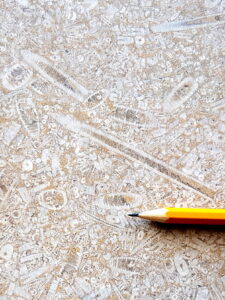
Rymans, 20 Temple Street
What appears at first glance to be an unassuming shop front is in fact one of Birmingham’s top fossils spots (right). It is clad with a limestone called Derbydene This is an ‘encrinite,’ now a rather old-fashioned word, referring to a limestone predominantly composed of the fragments of crinoids. More correctly it would be called a biosparite today. However, here the crinoids are so spectacular that it seems fitting that we apply a rock name which draws attention to this. The crinoids here are big and cannot be missed, with ossicles a centimetre or so in diameter and articulated stem-sections up to ten or more centimetres in length. It is quarried from beds in the Lower Carboniferous (c.340Ma) Eyam and Monsal Dale Limestone Formations around the quarry district of Cromford in Derbyshire.
Walk up Temple Street towards the Cathedral and turn right into Temple Row. Stop outside 61-63 Temple Row (Riva Blu restaurant at the time of this revision in 2025). The best viewing place is at the corner, the junction with Needless Alley.
10. 61-63 Temple Row, Riva Blu restaurant
The building on the corner of Temple Row and Needless Alley is properly called Union Chambers. It was designed in the 1930s by architects Ewan Harper, Bro. & Co. The ground floor was remodelled to accommodate the Allied Irish Bank which formerly occupied the premises. Looking up, the building is clad in Portland Stone, but of main geological interest here are the decorative granites used to clad the lower floor. Several granites, probably added at different times, are used to clad this building, which is why this façade looks a bit patchy.
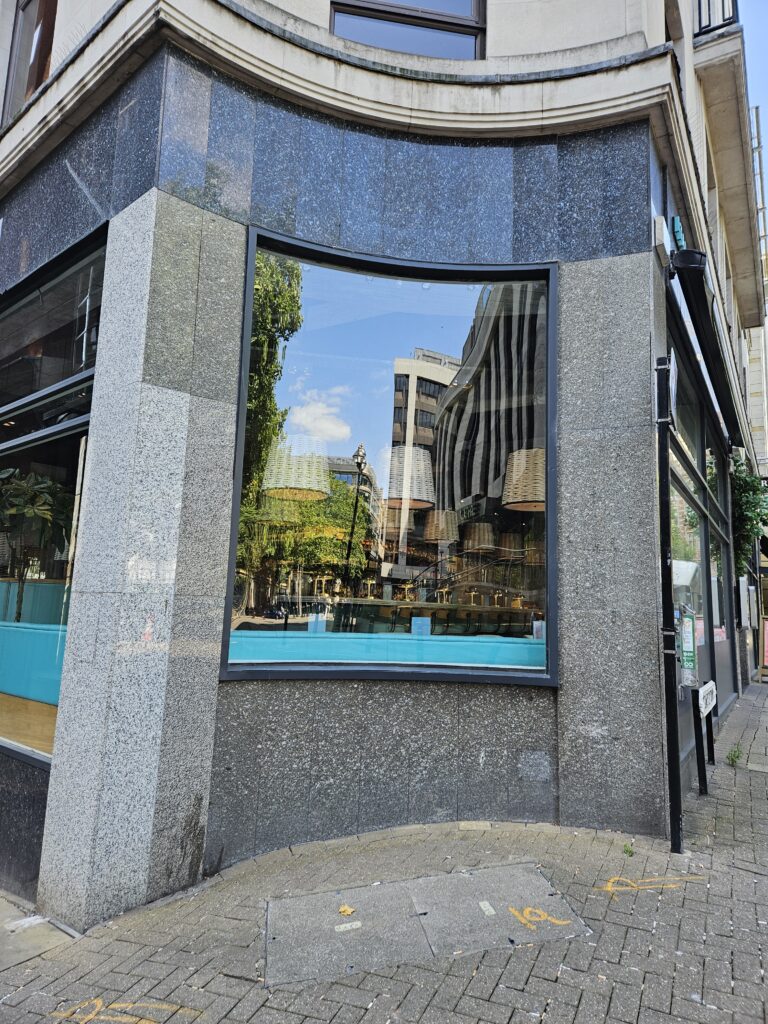
61-63 Temple Row, Riva Blu restaurant
We now turn to the granites which are used to clad the verticals around the door and between the windows. Unfortunately one of the main stones used is a granite of unknown origin, with blotchy, white plagioclase phenocrysts in a matrix of pale brown potassic feldspar, grey, translucent quartz and clots of black biotite mica. Also used are a very pale coloured leucogranite and a brown granite with strongly aligned phenocrysts. The leucogranite is a variety of Sardinian Granite with phenocrysts of slightly yellowish feldspars. This colour effect is partly due to incipient alteration of these minerals to form clays. Some of these crystals also show zoning. Grey quartz and black biotite are also present. This stone is quarried from the Buddosò Pluton, located in the north east of the island of Sardinia. It was intruded during the Variscan Orogeny 300 million years ago.

Above, left to right, brown granite, Sardinian Granite and Cornish granite. All images are at the same scale, field of view = 15cm.
The darker-coloured, foliated granite is a variety of Cornish Granite This texture is generally referred to as the ‘small-megacrystic type’ due to the brick-shaped feldspar phenocrysts, and granites with this texture were mainly acquired from the Carnmenellis and Bodmin Plutons. At 300Ma, the Cornish Granites are the same age as the Sardinian Granite above, and related to the same mountain-building event, the Variscan Orogeny. Both suites of granites were intruded late into this orogenic phase. Unlike the Sardinian Granites which contain only biotite mica, the Cornish granites are two-mica granites and silvery muscovite is a distinctive component of the stone used here. Biotite is present in black flakes, showing a weak alignment. Plagioclase and grey quartz are also present in the groundmass.
Turn around and look at the imposing building across Needless Alley which houses the offices of the CBRE. Take a look at the shiny brown cladding on the first floor of the building, and the contrasting white stone pitted with cavities at the base of the building. Cross Needless Alley for a closer look.

CBRE Building, 55 Temple Row
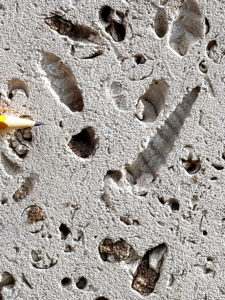
Fancy Beach Whitbed
This building, between Needless Alley and Cherry Street formerly housed the Bank of England, and was designed by Fitzroy Robinson & Partners (1972). It is now occupied by CBRE, a firm of California-based property developers. Two stones are used here; an unusual variety of Portland Stone and a brown granite. The Portland stone is best seen from ‘exposures’ at eye-level on the Needless Alley façade. This stone is packed with fossil fragments. It is Fancy Beach Whitbed a variety of Portland Stone which is much richer in fossils than normal Whitbed. It can be distinguished from the Roach facies in that the latter is dominated by cavities where fossils have been completely leached out. Fancy Beach Whitbed is packed with fossils but not all of these are leached out. The facies is particularly rich in the oyster Liostrea sp. and also debris of the algae Solenopora portlandica. The main shell varieties that are leached moulds and casts are from the bivalve Trigonia, and the gastropod Aptyxiella portlandica, (the ‘Portland Screw’). This facies named and worked by Albion Stone is mainly quarried in Jordan’s and Inmosthay Quarries on the Isle of Portland. Like all varieties of Portland Stone, this is an oolitic calcarenite of late Jurassic age. The adjoining wall to the left is also of Portland Stone, but a different variety. This is Portland Stone Whitbed containing fossils (including the oysters Liostrea sp and Spondylus sp), but they are far less prominent than in the adjoining Fancy Beach Whitbed. The Whitbed variety is the most commonly used variety of Portland Stone, and can be seen in civic and monumental architecture throughout the country and around the world. (Portland Stone is described in more detail in ‘Birmingham Building Stones’ Trail 2).
Blaubrun Granite is used for the first floor cladding above the Fancy Beach Whitbed, at the top of the steps to the front entrance. ‘Blaubrun’ literally translates from the German as ‘blue-brown’, referring to the brown potassic feldspars and bluish, strained quartz. This blue colour is an optical effect. Blaubrun is a coarse-grained, ancient granite from Sweden, one of the 1.8Ga Flivik-Hökhult Suite, with the main quarries located in the Ångeholm Pluton. This suite of intrusive igneous rocks is part of the Transcandinavian Igneous Belt which runs from Lofoten in northern Norway for 1400km to Blekinge province in south-east Sweden. They were emplaced in the Småland region of south east Sweden. They are exposed along the coast and the quarries are only accessible by boat. The rock also contains biotite and plagioclase.
Continue along Temple Row towards Cherry Street
Keep looking for fossils as you walk alongside the Portland Stone wall. Also look across the road to the Cathedral precinct. There are many natural stone features here and these are included in Trail 1 of the three Building Stones Trails of Birmingham City Centre.

Rapakivi granite, Baltic Brown
12. 43 Temple Row, Regus building
Originally built in 1980 for the Trustee Savings Bank by James A. Roberts Associates, this building is currently occupied by the Regus business centre. The building is clad in a popular ornamental stone known in the trade as Baltic Brown. This is a variety of ‘rapakivi granite’, and it is used to clad this building all along the façade on Cherry Street, providing excellent surfaces at eye-level to examine the textures and mineralogy of this rock. ‘Rapakivi’ is a Finnish word meaning ‘rotten rock’; a name coined due to the rubbly, surface weathering encountered in the Wiborg Batholith from whence this rock is quarried on the Finnish-Russian border. However the phrase ‘rapakivi granites’ applies to a range of anorogenic granites intruded between 1.6 and 1.5Ga in a zone extended from the Baltic Shield to the Southern USA. The variety we see here is the most well known and belongs to a group of rapakivi granites called wiborgites. These have the classic ‘ovoid’ textures of rounded, pink-brown potassic feldspars, rimmed by green plagioclase. Modern understanding of megacrysts in granitic melts is moving away from the interpretation that these are primary melt features and it is generally understood that these represent sub-solidus crystal growth.
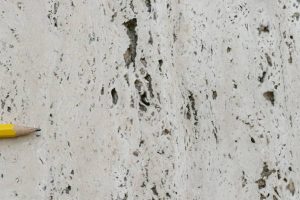
Tivoli Travertine
Continue along Temple Row alongside the House of Fraser building on your right. Stop to look at the cladding on this building and the paving stones underfoot.
13. House of Fraser and the paving
The shop is largely clad with a fine to medium-grained grey granite of unknown origin. It is composed of white, milky quartz and feldspar with abundant black biotite and minor muscovite. The feldspars are slightly altered and sometimes appear to be brown. Around the shop windows are strips of red Balmoral Granite, which like Baltic Brown described above, is another popular Finnish Stone, and again is part of the suite of rapakivi granites. These varieties, lacking the distinctive ovoids, are known as pyterlites. Balmoral is quarried from the Vehmaa Batholith, near Turku on the coast of SW Finland. Mineralogically it is composed of brick-red potassic feldspars, very dark, smoky quartz, plagioclase, biotite and hornblende. It has been marketed as ‘Balmoral’ since 1903, a time when Scottish-style baronial architecture was very popular in Scandinavia and Finland and also because the stone was marketed to the British Isles through the port of Aberdeen.
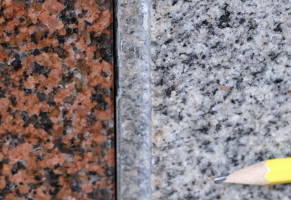
Red Balmoral Granite with unknown grey granite, House of Fraser
As you walk along note the paving stones beneath your feet. These are made of a sandstone known as York Stone. The colourful concentric lines in many of the paving stones are known as Liesegang bands, a form of staining produced from circulating ground water percolating through the rock.
Trail 3 continues on the next page…
